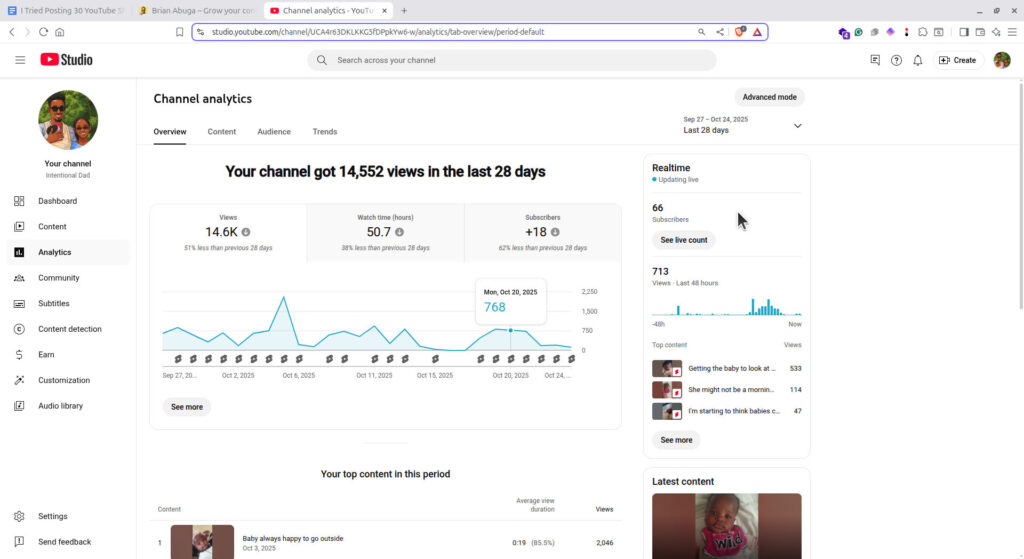If you’ve ever wondered whether posting daily YouTube Shorts can actually grow your channel, let me save you the suspense—it can, but not in the way you probably expect.
I recently started a new YouTube channel called Intentional Dad, where I document my everyday life as a father of two. Most of my Shorts are of my baby waking up every morning; those cute, spontaneous moments that melt your heart and make you smile before your coffee even kicks in.
I decided to challenge myself: 30 YouTube Shorts in 30 days.
No fancy camera. No editing suite. Just my phone, a bit of natural lighting, and my daughter doing baby things. I wanted to see what would happen if I committed to consistency without overcomplicating the process.
Here’s everything I learned, from views and subscribers to lessons I didn’t expect.
Why I Started the Challenge
Before I even uploaded my first video, I was already recording clips of my baby every morning. It wasn’t planned for YouTube at first—just normal parenting moments I wanted to keep for memories.
But since I have decent knowledge of content creation and monetization, I realized these short, authentic moments could actually perform well as YouTube Shorts. Platforms love short-form, relatable content, and who doesn’t love a cute baby?
Plus, I wanted to test something I often tell readers: you don’t need expensive gear to start creating content. You just need a phone, consistency, and a bit of intentionality.
My Posting Strategy
I decided early on that if I was going to do this, I’d do it properly.
That meant posting one video per day, every day, no excuses. Most of my videos were scheduled about a week in advance, so I never had to scramble for uploads. Scheduling is an underrated feature on YouTube; it removes pressure and lets you focus on content, not deadlines.
Each video is short, usually between 50 to 90 seconds, and centers around something simple: my baby stretching after waking up, smiling, babbling, or just lying there being adorable.
I upload directly from my phone. No editing apps, no extra gear, not even a tripod. It’s raw, real, and easy to maintain. That’s key when you’re a dad managing work, parenting, and a YouTube channel at the same time.
The Results (So Far)

At the time of writing this, my channel has just over 50 videos. I’ve gained 64 organic subscribers—no paid promotions, no shorts ads, no collaborations.
Each video gets around 1,000 views within the first 24 hours, and then things usually stagnate. They don’t completely die off, but YouTube seems to stop pushing them after a day or two.
I’m not entirely sure why this happens, but my best guess is that YouTube is still figuring out my audience. When you start a new channel, especially one that doesn’t fit neatly into a niche (like tech or gaming), the algorithm takes time to understand who to show your videos to.
Even so, 1,000 views per video on a new channel with no prior audience is solid. That’s roughly 30,000 views in a month from content I’d be recording anyway as a dad.
What Surprised Me the Most
The first surprise was how easy it was to stay consistent.
Because I was recording my baby every morning anyway, the content basically created itself. It wasn’t forced or staged, just part of our normal routine. The challenge didn’t feel like “content creation”; it felt like journaling with a camera.
The second surprise was how much YouTube rewards regular posting. Even though my views plateaued after a while, the early engagement told the algorithm, “Hey, this guy is active.” That consistency helps build a track record, which is crucial if you plan to transition into long-form content later.
The third surprise was how natural it felt to build a brand around fatherhood. I’ve written about productivity, money, and content creation before, but documenting my real life adds a different kind of authenticity.
When you love your kids, showing up on camera doesn’t feel like work; it’s automatic.
Crossposting to Instagram and TikTok
I also crosspost my Shorts to Instagram Reels and TikTok, but I don’t put much effort into those platforms. My goal is to grow primarily on YouTube, since that’s where monetization, affiliate marketing, and community-building make the most sense long-term.
That said, crossposting does have its benefits. It exposes your content to different audiences and can act as a backup plan if one platform slows down. But for me, I treat Instagram and TikTok as “bonus views,” not main platforms.
Lessons Learned After 30 Days
| Metric | Result | Notes |
| Total Shorts Posted | 30+ | Posted daily, scheduled one week in advance |
| Total Views (Est.) | ~30,000 | Average of 1,000 views per Short within 24 hours |
| Subscribers Gained | 64 | 100% organic — no paid promotions |
| Average Watch Duration | 8–15 seconds | Short videos, mainly baby waking-up moments |
| Main Recording Device | Smartphone | No special gear, lights, or editing tools |
| Crossposted To | Instagram, TikTok | Secondary focus; main growth target is YouTube |
| Channel Niche | Fatherhood & Lifestyle | Documenting daily life as a dad of two |
| Next Step | Long-form YouTube videos | Product-friendly topics for affiliate monetization |
1. Consistency beats creativity (at first)
When you’re starting, the most important thing isn’t to create viral content, it’s to build a habit. Posting every day for 30 days taught me discipline, not virality. You learn what works only after you have enough data to analyze.
2. Short-form growth is weird
Getting 1,000 views per video sounds great, but the numbers can mess with your expectations. Shorts traffic is volatile. Some days you’ll get 5,000 views in hours, then go a whole week without any traction. Don’t read too much into day-to-day numbers; focus on trends over time.
3. Analytics don’t lie
After a few weeks, I noticed most of my watch time came from new viewers (not returning), meaning my videos were getting sent to new viewers each time. It tells me my content is still being tested by YouTube—still hasn’t figured out who actually loves my content.
If you want to understand your channel’s direction, YouTube Analytics is your best friend. Check your retention graphs, click-through rates, and subscriber sources regularly.
4. Use what you have
Many creators delay starting because they think they need a camera, microphone, or editing setup. I’ve proven otherwise. All my videos are shot on my phone—no filters, no lighting rigs, just life happening in real time.
My Plan Going Forward
Now that I’ve built momentum with Shorts, the next step is long-form video.
I already have topics planned, many of which are affiliate product–friendly. I’ll be reviewing parenting gear, tech that makes family life easier, and documenting real experiences rather than polished product promos.
I also plan to monetize through YouTube’s Partner Program once I hit the requirements. The long-term vision for Intentional Dad is to blend storytelling, lifestyle, and financial lessons into something valuable for both parents and creators.
And honestly, it feels right. Because at the end of the day, I’m not pretending to be a YouTuber. I’m a dad who happens to film what he already loves doing.
What I’d Tell Anyone Starting a Shorts Channel
- Start small, stay consistent. Don’t overthink your niche or equipment.
- Schedule uploads in advance. It keeps you accountable and reduces stress.
- Watch your analytics, but don’t obsess. The algorithm needs time.
- Crosspost strategically. Treat other platforms as traffic boosters, not priorities.
- Think long-term. Shorts can get you attention, but long-form builds your brand.
If you’re looking to grow online without burning out, consistency and authenticity beat every growth hack out there.
Most Importantly
My 30-day YouTube Shorts challenge taught me something deeper than just analytics: it reminded me why I create.
It’s easy to get caught up in numbers, but behind every view is a person, and in my case, a story about family, love, and growth. I don’t have a viral channel yet, but I’m building something meaningful.
If you’ve ever thought about starting your own YouTube channel, do it. You don’t need fancy equipment or editing skills—just a story worth sharing and the discipline to show up daily.


